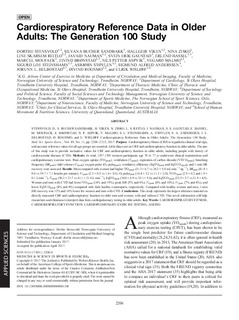| dc.contributor.author | Stensvold, Dorthe | |
| dc.contributor.author | Bucher Sandbakk, Silvana | |
| dc.contributor.author | Viken, Hallgeir | |
| dc.contributor.author | Zisko, Nina | |
| dc.contributor.author | Reitlo, Line Skarsem | |
| dc.contributor.author | Nauman, Javaid | |
| dc.contributor.author | Gaustad, Svein Erik | |
| dc.contributor.author | Hassel, Erlend | |
| dc.contributor.author | Moufack, Marcel | |
| dc.contributor.author | Brønstad, Eivind | |
| dc.contributor.author | Aspvik, Nils Petter | |
| dc.contributor.author | Malmo, Vegard | |
| dc.contributor.author | Steinshamn, Sigurd Loe | |
| dc.contributor.author | Støylen, Asbjørn | |
| dc.contributor.author | Anderssen, Sigmund Alfred | |
| dc.contributor.author | Helbostad, Jorunn L. | |
| dc.contributor.author | Rognmo, Øivind | |
| dc.contributor.author | Wisløff, Ulrik | |
| dc.date.accessioned | 2018-05-23T08:53:06Z | |
| dc.date.available | 2018-05-23T08:53:06Z | |
| dc.date.created | 2017-10-30T10:47:46Z | |
| dc.date.issued | 2017 | |
| dc.identifier.citation | Medicine & Science in Sports & Exercise. 2017, 49, 2206-2215. | nb_NO |
| dc.identifier.issn | 0195-9131 | |
| dc.identifier.uri | http://hdl.handle.net/11250/2498822 | |
| dc.description | This is an open-access article distributed under the terms of the Creative Commons Attribution-Non Commercial-No Derivatives License 4.0 (CCBY-NC-ND), where it is permissible to download and share the work provided it is properly cited. The work cannot be changed in any way or used commercially without permission from the journal. | nb_NO |
| dc.description.abstract | Purpose: Cardiorespiratory fitness (CRF) is regarded a clinical vital sign, and accurate reference values for all age groups are essential. Little data exist on CRF and cardiorespiratory function in older adults. The aim of this study was to provide normative values for CRF and cardiorespiratory function in older adults, including people with history of cardiovascular diseases (CVD).
Methods: In total, 1537 (769 women) participants age 70 to 77 yr underwent clinical examinations and cardiopulmonary exercise tests. Peak oxygen uptake (V˙O2peak), ventilation (V˙Epeak), expiration of carbon dioxide (VV˙CO2peak), breathing frequency (BFpeak), tidal volume (VTpeak), oxygen pulse (O2 pulsepeak), ventilatory efficiency (EqV˙O2peak and EqV˙CO2peak), and 1-min HR recovery were assessed.
Results: Men compared with women had higher V˙O2peak (31.3 ± 6.7 vs 26.2 ± 5.0 mL·min−1·kg−1), BFpeak (41.8 ± 8.0 vs 39.7 ± 7.1 breaths per minute), VTpeak (2.3 ± 0.5 vs 1.6 ± 0.3), O2 pulsepeak (16.4 ± 3.2 vs 11.3 ± 2.0), V˙CO2peak (2.9 ± 0.2 and 1.9 ± 0.1 L·min−1), V˙Epeak (96.2 ± 21.7 vs 61.1 ± 21.6 L·min−1), EqV˙O2peak (38.0 ± 6.9 vs 35.1 ± 5.6), and EqV˙CO2peak (33.5 ± 5.7 vs 31.9 ± 4.5). Women and men with CVD had lower V˙O2peak (14% and 19%), peak HR (5% and 6%), V˙Epeak (8% and 10%), VTpeak (7% and 4%), and lower EqV˙CO2peak (4% and 6%) compared with their healthy counterparts, respectively. Compared with healthy women and men, 1-min HR recovery was 12% and 16% lower for women and men with CVD.
Conclusions: This study represents the largest reference material on directly measured CRF and cardiorespiratory function in older men and women, with and without CVD. This novel information will help researchers and clinicians to interpret data form cardiopulmonary testing in older adults. | nb_NO |
| dc.language.iso | eng | nb_NO |
| dc.subject | aged/physiology | nb_NO |
| dc.subject | anaerobic threshold/physiology | nb_NO |
| dc.subject | anthropometry | nb_NO |
| dc.subject | cardiorespiratory fitness | nb_NO |
| dc.subject | exercise test | nb_NO |
| dc.subject | female | nb_NO |
| dc.subject | heart rate/physiology | nb_NO |
| dc.subject | humans | nb_NO |
| dc.subject | male | nb_NO |
| dc.subject | oxygen consumption/physiology | nb_NO |
| dc.subject | perception/physiology | nb_NO |
| dc.subject | physical exertion/physiology | nb_NO |
| dc.subject | reference values | nb_NO |
| dc.subject | respiratory function tests | nb_NO |
| dc.title | Cardiorespiratory Reference Data in Older Adults: The Generation 100 Study. | nb_NO |
| dc.title.alternative | Cardiorespiratory Reference Data in Older Adults: The Generation 100 Study. | nb_NO |
| dc.type | Journal article | nb_NO |
| dc.type | Peer reviewed | nb_NO |
| dc.description.version | acceptedVersion | nb_NO |
| dc.description.version | publishedVersion | nb_NO |
| dc.rights.holder | © 2017 The Author(s). | nb_NO |
| dc.source.pagenumber | 2206-2215 | nb_NO |
| dc.source.volume | 49 | nb_NO |
| dc.source.journal | Medicine & Science in Sports & Exercise | nb_NO |
| dc.source.issue | 11 | nb_NO |
| dc.identifier.doi | 10.1249/MSS.0000000000001343 | |
| dc.identifier.cristin | 1508834 | |
| dc.relation.project | Norges forskningsråd: 239875 | nb_NO |
| cristin.unitcode | 150,34,0,0 | |
| cristin.unitname | Seksjon for idrettsmedisinske fag | |
| cristin.ispublished | true | |
| cristin.fulltext | postprint | |
| cristin.fulltext | original | |
| cristin.qualitycode | 2 | |
